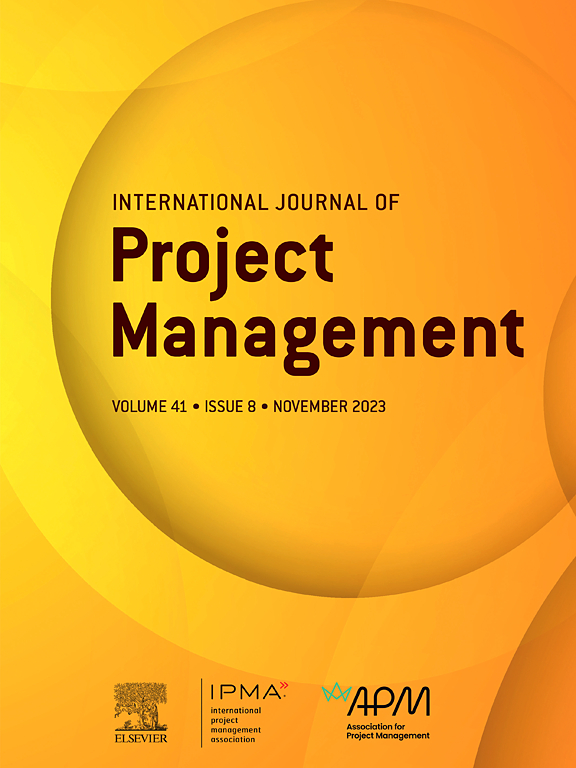Exploring the applicability of project alliancing to interorganizational projects: An alliance governance design matrix
IF 7.5
1区 管理学
Q1 MANAGEMENT
International Journal of Project Management
Pub Date : 2025-07-01
DOI:10.1016/j.ijproman.2025.102737
引用次数: 0
Abstract
The academic discussion on relational forms of project governance in general and project alliancing in particular has centred on megaprojects. The applicability of project alliancing to other types of interorganizational projects requires more attention. The aim of project alliancing is to promote goal alignment and innovativeness across project actors by sharing risks and rewards through an alliance contract. As interorganizational projects are prone to inter-actor conflicts, it is necessary to understand the utilization of project alliancing in various kinds of interorganizational projects. The aim of this conceptual study is to scrutinize the applicability of project alliancing to varying interorganizational projects. Building primarily on the project governance, relational contracting, project network, and project alliancing literatures, we analyze the common alliance applicability criteria and relational governance mechanisms, and introduce an alliance governance design matrix. The matrix combines the criteria for alliancing applicability with governance mechanisms and reveals ways of matching them in various interorganizational projects. Evaluating governance mechanisms in project alliancing and their connections with the applicability criteria helps extend the applicability of alliancing to versatile contexts and resolve potential inter-actor conflicts. For practitioners, we offer a framework for assessing the applicability of project alliancing in delivering the expected solutions, choosing appropriate governance mechanisms, and assessing organizations’ readiness to participate in alliances.
探索项目联盟对组织间项目的适用性:联盟治理设计矩阵
关于项目治理的关系形式,特别是项目联盟的学术讨论主要集中在大型项目上。项目联盟对其他类型的组织间项目的适用性需要更多的关注。项目联盟的目的是通过联盟合同分担风险和回报,促进项目参与者之间的目标一致性和创新性。由于组织间项目容易发生主体间冲突,了解项目联盟在各类组织间项目中的运用是十分必要的。这个概念性研究的目的是仔细检查项目联盟对不同组织间项目的适用性。本文以项目治理、关系契约、项目网络和项目联盟的相关文献为基础,分析了常见的联盟适用性标准和关系治理机制,并引入了联盟治理设计矩阵。矩阵结合了将适用性与治理机制结合起来的标准,并揭示了在各种组织间项目中匹配它们的方法。评估项目联盟中的治理机制以及它们与适用性标准的联系,有助于将联盟的适用性扩展到多用途环境,并解决潜在的参与者间冲突。对于从业者,我们提供了一个框架,用于评估项目联盟在交付预期解决方案、选择适当的治理机制以及评估组织参与联盟的准备情况方面的适用性。
本文章由计算机程序翻译,如有差异,请以英文原文为准。
求助全文
约1分钟内获得全文
求助全文
来源期刊

International Journal of Project Management
MANAGEMENT-
CiteScore
12.30
自引率
26.20%
发文量
83
审稿时长
59 days
期刊介绍:
The International Journal of Project Management is recognized as a premier publication in the field of project management and organization studies. Our main objective is to contribute to the advancement of project management and project organizing through the publication of groundbreaking research.
We are dedicated to presenting fresh insights and new knowledge in various domains, including project management, program management, portfolio management, project-oriented organizations, project networks, and project-oriented societies. We actively encourage submissions that explore project management and organizing from the perspectives of organizational behavior, strategy, supply chain management, technology, change management, innovation, and sustainability.
By publishing high-quality research articles and reviews, we strive to revolutionize the academic landscape and propel the field of project management forward. We invite researchers, scholars, and practitioners to contribute to our journal and be a part of the progressive development in this exciting field.
 求助内容:
求助内容: 应助结果提醒方式:
应助结果提醒方式:


